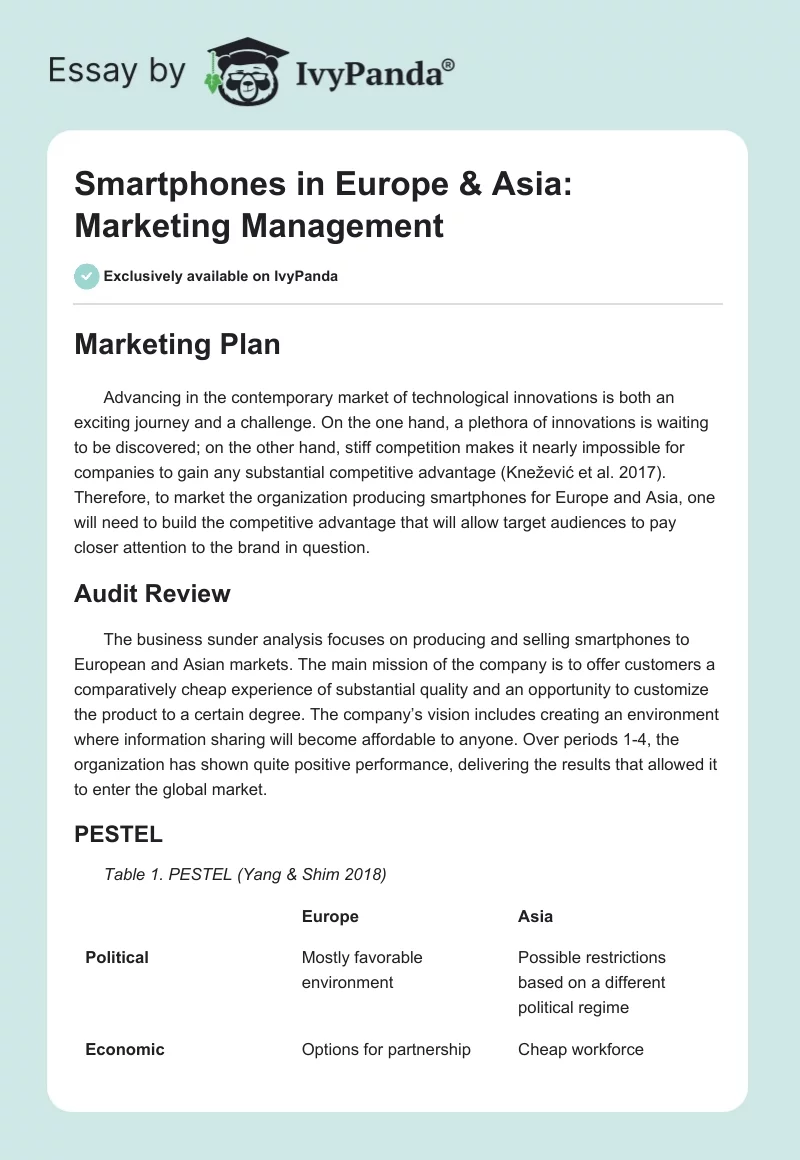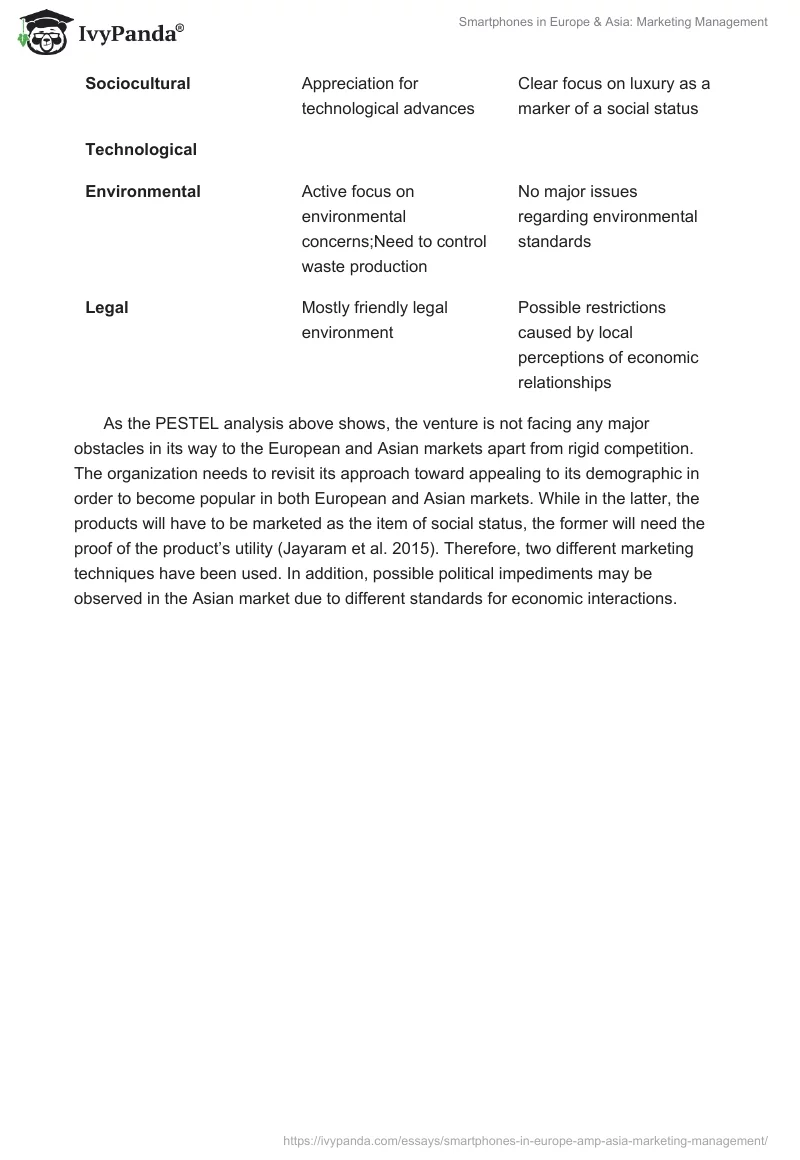Marketing Plan
Advancing in the contemporary market of technological innovations is both an exciting journey and a challenge. On the one hand, a plethora of innovations is waiting to be discovered; on the other hand, stiff competition makes it nearly impossible for companies to gain any substantial competitive advantage (Knežević et al. 2017). Therefore, to market the organization producing smartphones for Europe and Asia, one will need to build the competitive advantage that will allow target audiences to pay closer attention to the brand in question.
Audit Review
The business sunder analysis focuses on producing and selling smartphones to European and Asian markets. The main mission of the company is to offer customers a comparatively cheap experience of substantial quality and an opportunity to customize the product to a certain degree. The company’s vision includes creating an environment where information sharing will become affordable to anyone. Over periods 1-4, the organization has shown quite positive performance, delivering the results that allowed it to enter the global market.
PESTEL
Table 1. PESTEL (Yang & Shim 2018)
As the PESTEL analysis above shows, the venture is not facing any major obstacles in its way to the European and Asian markets apart from rigid competition. The organization needs to revisit its approach toward appealing to its demographic in order to become popular in both European and Asian markets. While in the latter, the products will have to be marketed as the item of social status, the former will need the proof of the product’s utility (Jayaram et al. 2015). Therefore, two different marketing techniques have been used. In addition, possible political impediments may be observed in the Asian market due to different standards for economic interactions.
Porter’s Five Forces
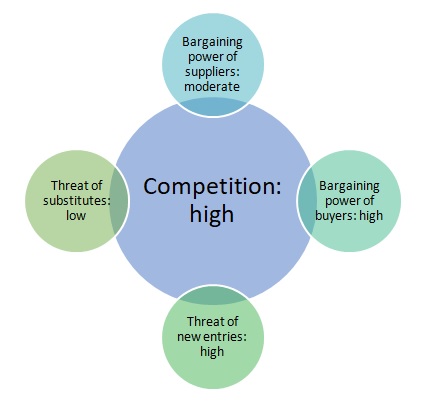
The outcomes of Porter’s Five Forces analysis indicate that the competition rates are devastatingly high in the target markets, especially in the European one. Due to the presence of established brands and their multiple clones, the market is quite saturated with the product in question, which is why the bargaining power of buyers is very high (Rahman et al. 2019). Consequently, the situation that the company faces in the European and Asian markets would have been dire unless a marketing campaign that showcases the product’s competitive advantage had been designed.
STP
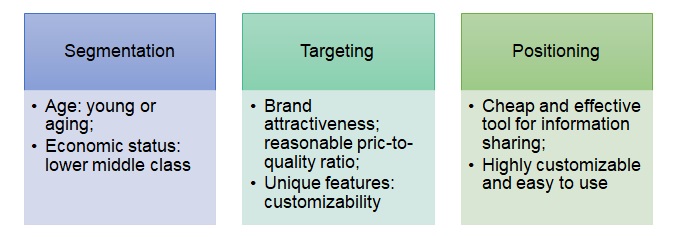
The model in question targets primarily young people, as well as lower middle class citizens. Since the company does not provide the brand of the same recognition and popularity as its competitors such as Apple, Samsung, Xiaomi, and others, the organization has to position itself as a unique, highly customizable and efficient tool that people with restricted financial resources will like. The specified approach has been quite effective in the target markets so far, leading to a rise in the company’s revenues.
Marketing Mix
Table 2. Marketing Mix.
The key product is the smartphone that appeals to both European and Asian markets. The task was quite difficult to implement due to differences in values of the target customers. Therefore, the product that appealed to the European customers’ need to save and the Asian buyers’ need to use the latest and highly customized technology was developed. Promoted as the tool for effective management of information for a reasonable price and with numerous customization options, the smartphone is set at a rather low price in both markets.
The approach that the company has been using to address the pricing issue and remain faithful to its price-to-quality ratio is one of the aspects of the company’s functioning that is worth noticing as an important one. Despite numerous challenges that have been hindering the firm’s progress in the Asian and European markets, the pricing strategies have remained the same, and customers are still provided with the products of impressive quality for comparatively low price. Therefore, the organization can boast significant consistency in its pricing approach. The specified point of the firm’s marketing has been especially important in attracting customers since the opportunity to save money has been an important aspect of European customers’ perspective (Shin 2015). The incorporation of luxury elements and additional options for navigating multiple applications has been used as the selling point for the Asian clientele (Zhang et al. 2016).
SWOT
Table 3. SWOT.
As the SWOT analysis performed below indicates, the project in question has numerous strengths, the main ones being its price-to-quality ratio and its customizability. However, the lack of a distinctive competitive advantage may set the brand back in the competitive chase. The opportunities that the brand can pursue in the European and Asian markets include increasing its consumer base and building a stronger presence. However, the threat of being overshadowed by a larger brand remains strong.
Moreover, the SWOT assessment has shown that the brand has reached impressive heights in promoting its products to the target demographic. While the specified characteristic is currently viewed as one of the main strengths and the aspect of the company’s success, it may become an impediment in the expansion to be planned for the organization to enter other markets. Shaping the existing product in the way that will catch the attention of a new audience and at the same time allow the organization to retain the current one is a highly challenging task to perform, especially for the company that cannot characterize itself as the corporate monster such as more recognizable brand names such as Xiaomi.
Marketing Plan
Presently, the organization needs to make its presence in the European and Asian markets as strong as possible. For this reason, the company will need to shape its brand personality slightly and make the distinction between the brand marketed to European customers and Asian ones more pronounced. Thus, the firm will appeal to culture-specific characteristics of buyers, encouraging them to purchase the product. Namely, other types of population in the specified markets will be marketed to and viewed as the main focus of the future promotion campaign. In addition, the current brand will have to be represented in a more neutral form that will make it simpler for the organization to enter the American market as well. With the brand that will retain its main characteristics, namely, the price-quality ratio and customizability, at the same time being highly flexible for adjusting to culture-specific needs of customer, the company will be able to enter any market with impressive success rates.
Objectives
The goals that the organization is pursuing currently are quite basic. Namely, it strives to attract the attention of a larger range of customers, including the segments that it may have overlooked before. While the product in question has been aimed primarily at students and lower middle-class citizens, the company will also have to try marketing it to other demographics such as business people and families to embrace every opportunity. Attracting the attention of the teenage audience may also become possible in the future.
Strategies
Achieving the objectives outlined above will require a large effort form the organization. A combination of further market penetration and product diversification will have to be used in order to keep the project successful. The suggested strategies will help the company to expand both in terms of its market influence and the range of services that it provides to its audiences. The expansion of the digital marketing approaches should also be viewed as an important change.
The importance of product diversification cannot possibly be overly emphasized in the case of the company in question. Since customizability is one of the main qualities that constitute the brand’s identity and its appeal to the target population, it will be critical to ensure that the product will remain pliable wen being introduced to new markets. Moreover, the introduction of new products associated with the brand, such as mobile applications targeted at customers based on their interests and culture-sepcific characteristics, will also have to be developed. The specified suggestions will help the company to keep its trademark appeal, while making its brand diverse.
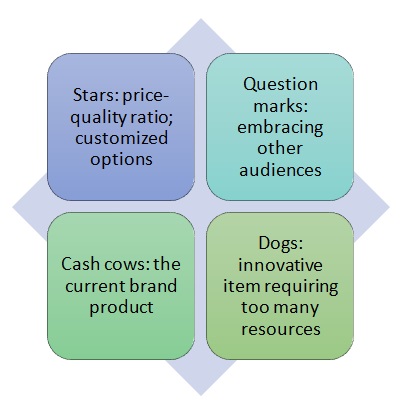
As the BCG matrix above shows, the company needs to rely on its brand products in order to foray into the new economic context, as well as cement its success in the present setting effectively. The development of the products that will have new functions appealing to the needs of the target demographic, in turn, can be seen as “dogs”. The smartphones that will be built to incorporate multiple applications for the comfort of Asian buyers, as well as the designs that will involve high functionality and a wider range of design options for European clients. Thus, the company will retain its current customers, at the same time attracting new ones.
Therefore, the company will have to diversify its product significantly in order to meet the needs of its customers. The creation of other variations of the brand product may be needed to cater to the needs of the firm’s new audiences, which currently include families and business people, as well as possibly other continents. For this purpose, the firm will have to place emphasis on the R&D processes and revisit the marketing strategies that it has been using to attract the attention of its Asian and European clients.
Marketing Mix Tactics
The current marketing mix tactic is aimed mostly at creating a cos-efficient pricing strategy and positioning the product as a compromise between financial constraint of buyers and their requirements for quality. However, the introduction of new customizing options that will allow business people and families to become interested in the product will bolster the company and offer it the chances to penetrating the market deeper. Therefore, the proposed marketing mix includes aiming at people of other age ranges and, possibly, the representatives of the middle class.
Planning and Implementation Controls
To plan the introduction of a new set of marketing strategies and the creation of an innovative marketing framework for appealing to a broader audience, the company will have to use several techniques that will leverage its current position and allow the firm to gain competitive advantage. For example, the integration of benchmarking into the process of addressing the existing concerns within the organization will have to be used. Notably, the firm is continuing to penetrate the Asian and European markets, yet also enters the new territory in terms of the audience to which it will appeal in the designated environment. Thus, it will be necessary to incorporate flexible control tools for alleviating risks and reducing the exposure of the company in question to the threats of being ousted from the market by its more successful competitors. Thus, the use of benchmarking as the method of identifying the quality standards which the organization will have to meet is essential. In addition, the introduction of the Corporate social Responsibility by using the Transformational Leadership technique will be needed to keep the staff members invested. The key performance indicators that will be used to measure staff’s efficacy will include engagement, percentage of errors, and compliance with set standards for quality and workplace performance.
Quantitative Forecast
Table 4. Financial Projections: 2020-2022.
As the table above shows, it is believed that the suggested practice will help to raise the company’s profits by at least 5%. Changes in the firm’s general appeal and the marketing framework, as well as its target demographic, is expected to cause an increase in the range of audiences that will be attracted by the brand. Moreover, the introduction of an innovative approach toward the brand architecture process will lead to the company developing new branches of its products and grasping the attention of diverse audiences.
As a result, the profits of the organization are bound to rise with the introduction of a new focus that will allow attracting new audiences. Although the current pace at which the organization has bene evolving approaches the mark of satisfactory progress, further advancement into the European and Asian markets, as well as the focus on new economic environments, namely, the U.S., is inevitable.
Critical Evaluation
In order to ensure that the project succeeds in the target market, the tools for evaluating it critically will have to be introduced. An objective assessment of the chances that the organization has in the European and Asian markets will shed light onto the options that it will have in other economic environments, as well as with different types of customers and a more diversified line of products. In order to make sure that the company meets the set objectives and gains the attention of new customers, at the same time diversifying its products, it was be necessary to introduce the planning tools based on the concept of strategic planning.
The use of the SWOT model will be particularly helpful due to the chance to identify and summarize the key characteristics of the internal and external factors that influence the organization’s performance. Namely, the SWOT tool set the scene for the assessment of the advantages and disadvantages of the current approach used by the organization to manage its performance and address customers’ needs. Specifically, the approach in question highlighted the inherent qualities of the organization, including positive and negative ones, and outlined the prospects for its performance in the market, embracing the influences that offer opportunities and those that pose risk.
One might argue that the application of the SWOT tool offers rather generic results that cannot be used directly to inform further strategies for operating, especially in a new environment. However, the SWOT model provides a chance to compartmentalize the key influences, assigning each outcome to a particular aspect of the company’s performance. Therefore, as a method of exploring the firm’s chances in the Asian and European smartphone markets, the SWOT technique provided quite a range of opportunities. The method helped to define the general trends in each aspect of the firm’s functioning, including internal and external issues, to detail the changes that have to be made.
However, the SWOT analysis suffers from the lack of objectivity, as well as the absence of any restrictions concerning the number and type of factors that need to be included into the analysis. The same can be said about PESTEL and Porter’s Five Forces, which provide general statements concerning the status of the target market, yet lack specificity. As a result, the accuracy of the outcomes suffers to a significant degree. In order to manage the disadvantages of the SWOT tool, one may have to incorporate the VRIO assessment tool as the method of embracing the objective characteristics of the target environment and the chances that the company has in the Asian, European, and, possibly, American contexts (Chen & Ann, 2014). The incorporation of the balanced scorecard technique might also reveal multiple factors that affect the company’s performance and especially its endeavours at entering the new market and attracting new customers.
Key Planning Tools
The process of planning also implies dealing with the analysis of the structure of relationships between the company and its stakeholders. In the context of the supply chain that the present organization has developed in the Asian and European markets, it is important to consider how the organization manages to develop trust-based relationships with its buyers. For this purpose, the use of the mind-mapping techniques should be considered (Kofahi & Alryalat 2017). Mind-mapping will allow the company to locate connections between different aspects of its performance, at the same time keeping the eye on the latest trends and interweaving them into its functioning organically. The model also allows incorporating the tools such as brainstorming, which will lead to the creation of multiple effective decisions and cause a rapid economic growth in the company (Bocken et al. 2015). With the two techniques combined, the firm will be capable of considering introducing the principles of incremental changes into its production design.
Moreover, the techniques associated with collaboration and especially interdisciplinary cooperation within the company should be seen as the priority for the firm at present as far as the planning tools are concerned (Antonaci et al. 2015). The organization needs fresh ideas for pursuing the opportunities that the target market holds for it, as well as discovering new tools for implementing its practices in the best way possible. Thus, the focus on collaboration must remain consistent.
Finally, the selection of digital tools for supporting organizational planning and enhancement of organizational processes will have to be considered. For this purpose, the company will need to update its planning kit on a regular basis as soon as an innovative application is created to offer new options in the planning process. Currently, the digital tools such as the performance tracking software will be crucial for keeping the firm responsive to the key changes occurring in the target markets (Langlois & Chauvel 2017). The use of online tools for planning, collaboration, maintaining communication, and keeping all participants aware of the changes made to the set framework for corporate performance is essential. Thus, the company will maintain the continuity of it organizational processes, production, supply chain management, customer relations, and other areas. Moreover, the use of the designated tools will help company members to view their workplace environment as a single entity with every process affecting the other. Thus, staff members are likely to develop understanding of the company’s needs, their role in it, and the responsibility that they need to take.
Theories and Concepts
In order to evaluate the effectiveness of the current framework, several theoretical concepts will need to be reviewed. To create the perpetual cycle of change within the organization, the frameworks such as Kotter’s 8-step Model and Lewin’s Change Model will have to be considered. While Lewin’s theory is quite basic and suggests that only three steps should be taken to implement change, specifically, the freeze, change, and unfreeze phases, Kotter’s eight steps are the extension of the specified idea. Thus, using Lewin’s Theory as the basis and Kotter’s Model as the tool for setting further objectives, one will move the company toward its current goal of attracting more attention in the European and Asian markets, as well as trying to establish its presence in the American one (Hooda & Chhillar 2015).
Another model of change that the organization may need to try is the McKinsey 7-S model. Revolving around the notion of shared values, the model provides extensive opportunities to create the value system based on which the organization will develop further tools for maintaining flexibility toward customers’ demand sand technological innovations (Ravanfar 2015). In fact, the transition to the philosophy of innovativeness as the foundation of the organizational shared values will help the company to manage the threats that disruptive innovations will pose to its integration into the target markets. As new technologies emerge, the company will use the available tool to incorporate these innovations into its products and provide customers with the latest ITC opportunities. Thus, the firm will be able to respond to changes immediately.
Keller’s Consumer-Based Brand Equity Model
Viewing the company’s brand from the perspective of Keller’s framework will help to understand how the organization manages to cater to the needs of such diverse audiences ad at the same time keep its brand integrity and image intact. Using the model in question, one will realize that the company has developed a rather strong sense of self in the selected market (Yousaf, Amin & Gupta 2017). Although the identity in question cannot be defined as larger than life, as some of the firm’s competitors may boast, it still has a definitive set of standards and a unique philosophy based on which the product is developed. Namely, the brand identity of the company is based on the concept of providing people with advanced technologies for a sensible price-quality ratio and at the same time offering highly customizable options as far as the use of the devise is concerned (Çifci et al. 2016). Thus, the salience of the brand is maintained. The presence of salience helps to connect the company’s performance to the image that it has constructed of itself. Namely, the existing perception of the organization as the single entity where every performance aspect affects the other will affect the judgments and feelings about the company’s goals and the role of staff members in it (Theurer et al. 2016). As a result, the development of resonance and loyalty in employees is expected according to the model.
Co-Creation of Value
The process of creating value has been quite easy for the company despite the presence of numerous competitors and the fact that the smartphone industry has already been dominated by several brands that have practically monopolized the environment, specifically, Apple (iPhone) and Microsoft (Android). Tue to the focus on customizable devices, the company has been exploring the opportunities for engaging in a dialogue with its customers for a while. In fact, reciprocity has become one of the main pillars on which the company’s quality management was built. Therefore, the communication channels developed by the organization deserve the name of the main factors that have contributed to the co-creation of value.
However, the current stage of co-creating value is far from being over at the firm. Since the organization is planning to enter every market of Europe and Asia, cementing its status of a commonly used brand there, as well as possibly enter the American market, it will be necessary to revisit some of the approaches toward value co-creation. For instance, the use of the Big Data will be inevitable in reshaping the company’s approach toward value co-creation (Ramaswamy & Ozcan 2016). As the firm expands, so will its customer base, which will create the need to segment it in a more elaborate manner.
The co-creation of value will have to start with opening the access to information to target buyers. People need to be aware of the changes that the organization is planning to implement to its current products in order to decide whether they are going to buy these products or not. By being open and honest with its target demographic, the firm in question will be able to develop the system of reciprocity and collaboration that will lead to a better understanding of the target audience’s needs (Iglesias et al. 2017). The specified change will be not only crucial but also inevitable in the new market setting, as well as with new audiences in the current one since the organization will need to find out how to cater to their needs.
To make sure that all target audiences are involved in the dialogue, the firm will have to build thematic communities in which the discussion of the subject matter will be possible. Granted that moderating these communities and responding to every feedback or query submitted by participants is going to be quite painstaking and time-consuming, the specified approach is expected to pay off as the company advances in the market by offering the exact devices that customers need.
It or worth noting that the strategy described above does not negate the need to introduce innovative solutions that will surprise the target audience. Quite the contrary, staying innovative and providing original solutions to communication issues should be one of the many aspects of the company’s performance. However, it is also crucial to establish reciprocity in the relationships between the organization and the community to which it caters. Therefore, the process of the co-creation of value must start with the development of additional communication channels and the promotion of the cross-cultural conversation with the target audiences (Laamanen & Skålén 2015). Afterward, the principles of networking will have to be integrated to connect the participants of the communication process and engage them in the continuous dialogue with the firm. The information flow that the specified change will cause will lead to the effective change management within the organization. Moreover, the described alteration in the management of customer relations may cause a change in the corporate philosophy and the transition to the change-oriented model. Thus, the firm will be able to meet the needs of the audience with every new demand.
Reference List
Antonaci, A, Dagnino, F, Ott, M, Bellotti, F, Berta, R, De Gloria, A, Lavagnino, E, Romero, M, Usart, M & Mayer, I 2015, “A gamified collaborative course in entrepreneurship: Focus on objectives and tools”, Computers in Human Behavior, vol. 51 pp. 1276-1283.
Bocken, N, Rana, P & Short, S 2015, “Value mapping for sustainable business thinking”, Journal of Industrial and Production Engineering, vol. 32, no. 1, pp. 67-81.
Chen, C & Ann, B 2014, “Efficiencies vs. importance-performance analysis for the leading smartphone brands of Apple, Samsung and HTC”, Total Quality Management & Business Excellence, vol. 27, no. 3-4, pp. 227-249.
Çifci, S, Ekinci, Y, Whyatt, G, Japutra, A, Molinillo, S & Siala, H 2016, ‘A cross validation of Consumer-Based Brand Equity models: Driving customer equity in retail brands’, Journal of Business Research, vol. 69, no. 9, pp. 3740-3747.
Hooda, I & Singh Chhillar, R 2015, “Software test process, testing types and techniques”, International Journal of Computer Applications, vol. 111, no. 13, pp. 10-14.
Iglesias, O, Ind, N & Alfaro, M 2017, ‘The organic view of the brand: a brand value co-creation model’, Advances in corporate branding, Palgrave Macmillan, London, pp. 148-174.
Jayaram, D, Manrai, A & Manrai, L 2015, “Effective use of marketing technology in Eastern Europe: Web analytics, social media, customer analytics, digital campaigns and mobile applications”, Journal of Economics, Finance and Administrative Science, vol. 20, no. 39, pp. 118-132.
Knežević, B, Stefańska, M & Stojković, D 2017, “A general overview of usage of smartphones and mobile applications by young consumers in Poland, Croatia and Serbia”, Przedsiębiorczość Międzynarodowa, vol. 3, no. 1, pp. 211-227.
Kofahi, I & Alryalat, H 2017, “Enterprise Resource Planning (ERP) implementation approaches and the performance of procure-to-pay business processes”, International Journal of Information Technology Project Management, vol. 8, no. 1, pp. 55-71.
Kurniawan, R, Haizam Mohd Saudi, M & Raphael Wijaya, Z 2018, “The influence of brand equity and STP towards pricing strategy and the impact on decision making”, International Journal of Engineering & Technology, vol. 7, no. 4.34, p. 318.
Laamanen, M & Skålén, P 2015, ‘Collective–conflictual value co-creation: a strategic action field approach’, Marketing Theory, vol. 15, no. 3, pp. 381-400.
Langlois, A & Chauvel, B 2017, ‘The impact of supply chain management on business intelligence’, Journal of Intelligence Studies in Business, vol. 7, no. 2, pp. 1-8.
Rahman, M, Jahan, B, Nipu, M, Nahar, S, Aktar, M, Islam, N, Hossain, M & Arif, M 2019, “An analysis of smart-phone industry in Bangladesh using Porter’s Five Forces Model”, OALib, vol. 06, no. 09, pp. 1-5.
Ramaswamy, V & Ozcan, K 2016, ‘Brand value co-creation in a digitalized world: an integrative framework and research implications’, International Journal of Research in Marketing, vol. 33, no. 1, pp. 93-106.
Ravanfar, M 2015, “Analyzing organizational structure based on 7s model of McKinsey”, International Journal of Academic Research in Business and Social Sciences, vol. 5, no. 5, pp. 1-7.
Shin, D 2015, “Effect of the customer experience on satisfaction with smartphones: Assessing smart satisfaction index with partial least squares”, Telecommunications Policy, vol. 39, no. 8, pp. 627-641.
Theurer, C, Tumasjan, A, Welpe, I & Lievens, F 2016, “Employer branding: a brand equity-based literature review and research agenda”, International Journal of Management Reviews, vol. 20, no. 1, pp. 155-179.
Yang, S & Shim, J 2018, “The effects of service qualities on customer satisfaction, trust, and behavioral intention in smartphone shopping malls”, Journal of Industrial Distribution & Business, vol. 9, no. 12, pp. 31-43.
Yousaf, A, Amin, I & Gupta, A 2017, ‘Conceptualising tourist based brand-equity pyramid: an application of Keller brand pyramid model to destinations’, Tourism and hospitality management, vol. 23, no. 1, pp. 119-137.
Zhang, H, Liang, X & Wang, S 2016, “Customer value anticipation, product innovativeness, and customer lifetime value: The moderating role of advertising strategy”, Journal of Business Research, vol. 69, no. 9, pp. 3725-3730.

